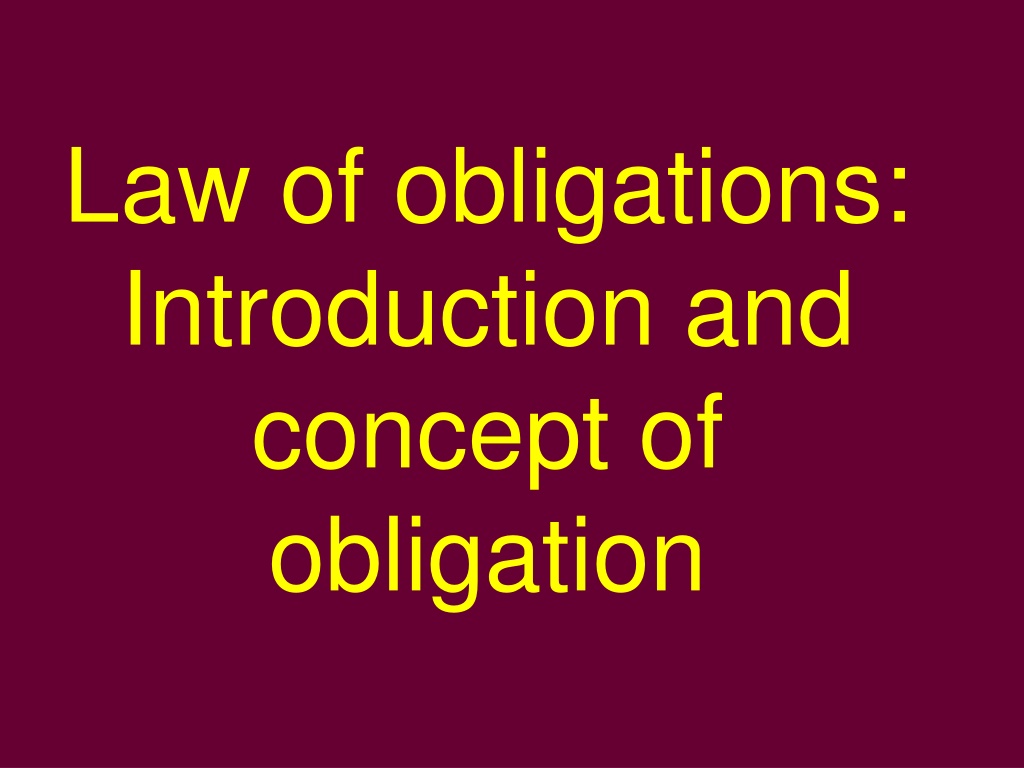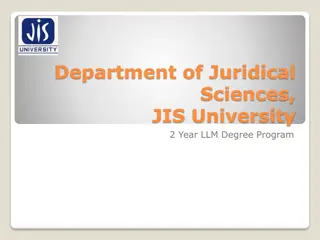The Concept of Obligations in Law
Introduction to the concept of obligations in law, exploring definitions by Paul and Justinian, development of obligations, legal relationships, equality of parties, and obligations in Roman law including actio suits and the origins of obligations in the Law of Twelve Tables.
Download Presentation

Please find below an Image/Link to download the presentation.
The content on the website is provided AS IS for your information and personal use only. It may not be sold, licensed, or shared on other websites without obtaining consent from the author.If you encounter any issues during the download, it is possible that the publisher has removed the file from their server.
You are allowed to download the files provided on this website for personal or commercial use, subject to the condition that they are used lawfully. All files are the property of their respective owners.
The content on the website is provided AS IS for your information and personal use only. It may not be sold, licensed, or shared on other websites without obtaining consent from the author.
E N D
Presentation Transcript
Law of obligations: Introduction and concept of obligation
Pauls definition: The essence of the obligation is not make some things or servitudes ours but to enforce second party to gives us something or to provide us with service
Justinian's definition: "The obligation is a legal bond that compels us to provide certain things according to the laws of our country."
Development of obligation: * initial source of obligation: damages done to estate of another pater familias * development of contracts due to need to use someone else estate
Obligation as a legal relationship: The obligation (obligatio) is a legal relationship between two parties, one of which is a creditor (creditor) and the other debtor (debitor).
Obligation is build on the principle of equality of contracting parties, which means that creditor has no power over debtor. Obligation was not only a legal relationship, but was also treated as property (part of res incorporales immaterial property) which can be subject of businnes transactions.
Obligation and actio (suit) In Roman law obligation was strictly bonded to specific suit without suit obligation wasn t enforceable. New obligations was created by adding judicial provisions to new types of agreements.
Relations not covered by any actio could be subject of granting special provision by pretor. Pretor could grant actio in factum suit build on facts that were foundation of parties relationship.
Origin of obligation in the Law of Twelve Tables I. Contracts II. Torts
Origin of obligation in Gaius s Res cottidianae I. Contracts II. Torts III. Various types of causes.
Origin of obligation in Corpus Iuris Civilis Contracts II. Torts III. Obligation arising from situation that resembles contract contractu) IV. Obligation arising from illict act not qualified as delict (quasi ex delictu) I. (quasi ex
Development of contractual obligation * numerus clausus of contracts in archaic roman law * rise of unnamed contracts - enforceable if one of the parties performed their duties * liberalization of formalities in case of oral contract of stipulation * genesis of pacta sunt servanda principle: Pacta quantumcunque nuda servanda - All naked contracts should be protected (Decretals of Gregory IX)
Civil obligations Where enforceable by law, which means: 1. They could be a subject of civil litigation 2. They were legal foundation of executing one s rights
Natural obligations Contrary to civil obligations they weren t enforceable by law, which means they weren t protected by suit and weren t basis for execution.
Natural obligations This type of obligation was usually effect of contracts made by: Slaves Persons under patria potestas Persons under tutelage (minor and women) Persons that had changed their legal status
Natural obligations This type of obligation had certain legal effects: * Fulfillment of this obligation is performing of legal duty * They can be strengthen by pledge * Person that provided peculium could cover his expenses based on that type of obligation in first place before other creditors
Unilaterly bidding contracts This type of obligation had very simple structure: only one party was a creditor and only one was a debtor. In civil litigation only creditor possesed a suit. Usually it was actio stricti iuris. Example: contract of loan
Bilaterally biding contracts (perfect) * both sides were creditors and debtors to each other * both sides possessed actiones to exercise their rights in the civil litigation * principle of equivalence of provisions
Bilaterally biding contracts (imperfect) * at the start they looked like unilaterally binding obligations * in some causes another obligation bond within the same contract and between the same parties could arise - for example in case of damages caused by the object of deposit in the estate of depositary * this second obligation had opposite directions - debtor of primary obligation become creditor and vice versa
Stricti iuris obligations * oldest and simplest type of obligations * upon evaluation judge didn t considered parties performance contract but examined initial party agreements after conclusion of
Bonae fidei obligations * judge could take into account various aspects of contractual relationship - such as pacta adiecta, interest or estate revenue * judge could award compensation to one party due to other party performance
Joint obligation (joint liability) * despite the fact that there are multiple debtors or creditors there was only one debt to fulfill * in case of one debtor who fulfill whole debt in name of the others was created grounds for recourse claims
Subject of obligation Subject of obligation in a one of the following forms: dare - to give something to someone facere - to provide someone with services praestare - to restrain ourselves from doing something or a guarantee obligation
Subject of obligation Claim need to be: * possible to implement * in accordance with the law * in accordance with the morality * sufficiently precise * economically valuable
Clauses that could modified content of the agreement: * rebus sic stantibus clause * good faith (bonae fidei) clause * good practice (boni mores) clause
Subject of obligation Debt could be describe in a specific or general terms which had different effects: * when subject of obligation was specific item in case of it s loss the risk was borne by creditor * when subject of obligation was describe as a item which hade some defined parameters it was always possible (in case of loss or damage) to provide creditor with new item
Impossibility of claim * Impossibilium nulla obligatio as a principle * Impossibility after agreement: - case of vis maior - case of one s party fault
Alternative obligation (Obligatio alternativa) Duae res sunt in obligatione, una in solutione - Two claims in obligation, one in solution
Alternative authorization (Facultas alternativa) Una res est in obligatione, duae in solutione - One claim in obligation, two in solution
Delay (mora) * situation when obligation wasn t fulfilled in timely manner * in case of obligation without specific due date summon was required * in case of obligation with specific due data expiration of this period was sufficient * in case of obligation arisen from a tort debtor was always in delay
Foundation of contractual liability Damages in one party s affairs Causal link Fault of second party
Degrees of fault dolus culpa culpa lata culpa levis in abstracto in concreto
Fault (culpa) Culpa lata great negligence; Culpa levis lesser degree of negligence which consist neglect of care that we used to expect from: a) culpa in abstracto diligent partner or good host b) culpa in concreto from debtor who act in his own affairs
Principles of liability Primary principle: fault as a ground for legal liability Secondary principles: custodia and risk (quasi-delicts) Magna culpa dolus est great negligence had the same legal effects as intentional fault Dolus semper praestatur - liability in case of intentional fault couldn t be excluded Casus a nullo praestatur responsible for fortuity - no one is
How to secure obligations? If suability and enforceability of obligation wasn t enough creditor implement some additional securities to primary agreement. might want to Forms of securities were divided into: I. Those made by debtor himself II. Those made by third party for debtor
Types of securities made by debtor Liquidated damages/ contractual penalty Down payment (arra) Lien (fiducia, pignus, hypotheca) Constitutum debiti proprii re-pledge of debt in form of pactum
Types of securities made by third parties Surety (adpromissio) Intercession which could create another debtor or only guarantor Credit mandate (mandatum qualificatum) Constitutum debiti alieni guarantee of debt in form of pactum by third party










